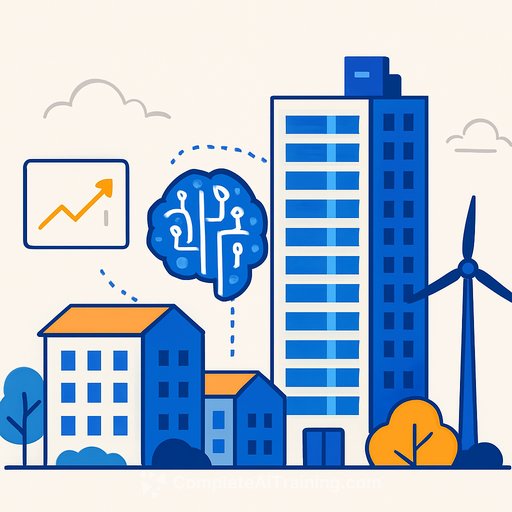Prologis Moves Beyond Warehouses: Building AI-Ready Real Estate and Energy Systems
Prologis plans to spend $8 billion over four years to build 20 data centers, with a path to as many as 100 projects. The goal is clear: extend industrial dominance into the facilities and energy networks that run artificial intelligence.
Leadership is calling for "energy from all sources" - nuclear, natural gas, solar, and other renewables - to meet a surge in demand. This is less about conventional real estate and more about building infrastructure that operates as a utility-grade platform.
Why This Matters for Real Estate and Construction
U.S. data center count hit roughly 5,400 in early 2025, more than double five years prior, driven by AI and cloud expansion. Major chipmakers expect global data center spending to reach trillions by decade-end, shifting capital and permitting attention to power-first sites.
For owners, developers, and contractors, this reshapes value: proximity to generation, interconnection speed, water availability, and conversion potential may outweigh traditional logistics metrics.
The Energy-First Thesis
Prologis is turning its 1.3 billion square feet of rooftops into distributed generation, including 45 new solar projects in northern Illinois. Partnerships with SolarEdge and Southern California Gas signal a push into renewable capacity and grid resilience.
The company cites about 3.4 gigawatts of data center power in operation or advanced development. Many existing assets near major metros are candidates for conversion; an 832-acre Atlanta site (Project Sail) and a campus developed with Skybox Datacenters outside Austin underline this direction.
Build Near Power, Not Just Near Demand
U.S. Interior Secretary Doug Burgum stressed that "national security is energy security" and urged building AI facilities close to generation to avoid years of transmission permitting. Expect more campuses adjacent to nuclear, large gas plants, or high-capacity substations.
Nuclear Returns to the Conversation
Rebecca Kujawa, former NextEra Energy Resources CEO, argues that nuclear is needed to cover baseload for hyperscale operations. Amazon Web Services has aligned with Dominion Energy (exploring small modular reactors in Virginia) and expanded supply from Talen Energy's Susquehanna plant.
Constellation Energy CEO Joseph Dominguez highlighted what data center customers want: 24/7 supply with long-term, firm pricing. Permitting reform and public-private partnerships will be required to scale nuclear and speed interconnections.
Action Plan for Owners, Developers, and Contractors
- Prioritize power-first site selection: Target parcels near high-capacity substations, generation hubs, and existing transmission corridors.
- Interconnection strategy: Engage utilities early, model queue timelines, and secure capacity reservations where possible.
- Water constraints: Design for low-water or waterless cooling options (air-cooled chillers, liquid-to-chip, adiabatic systems) and assess local withdrawals carefully.
- Warehouse-to-data center conversions: Evaluate structural loads, clear heights, floor loading, setback, and utility easements to fast-track "higher and better use."
- Power procurement: Structure PPAs, tolling agreements, and behind-the-meter strategies; consider microgrids and onsite solar with storage.
- Grid resilience: Engineer for N+1 or better redundancy, dual feeds, onsite generation, and black-start capabilities.
- Thermal and electrical design: Plan for high-density racks, robust switchgear, and scalable cooling, with phased capacity adds.
- Permitting and timelines: Map critical-path approvals (zoning, environmental, interconnection) and pre-negotiate local conditions.
- Cost control: Lock equipment lead times (transformers, chillers, generators), manage commodity exposure, and phase capital to match lease-up.
- Fiber and latency: Secure dark fiber routes, diverse paths, and meet-me options; proximity to cloud on-ramps reduces time-to-service.
- Community and workforce: Align with local officials on tax incentives, training pipelines, and construction labor capacity.
Where Prologis Is Headed
The company's next phase blends data center development with energy buying and generation. Expect more conversions in urban-edge logistics hubs and large-scale campuses near power sources, like the Skybox partnership in greater Austin and the Atlanta site.
Risks You Should Price In
Water availability, long equipment lead times, and grid interconnection delays are real constraints. Sites that solve for baseload, transmission access, and local permitting will win; everything else gets stuck in queues.
Helpful Resources
- U.S. Department of Energy: Data Center Efficiency
- Nuclear Regulatory Commission: Small Modular Reactors
Stay Ahead of AI Demand
If your portfolio is near major metros or generation hubs, a data center program might be your fastest path to value creation. For teams building capabilities around AI-driven demand, see training by role at Complete AI Training.
Your membership also unlocks:






